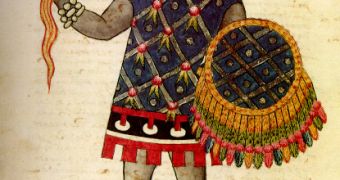We know Aztecs were deeply religious and used to offer hearts, while still beating, to their mighty gods, pulled out from the chests of their victims.
Now, archaeologists discovered into a crater lake of the snowcapped volcano Nevado de Toluca some wooden scepters with lightning bolts shapes fitting the description of Spanish priests and conquerors' writings, which are 500 years old, about the offerings the Aztecs made to their rain god.
Beside the bolts, the researchers also found cones of copal incense and obsidian knives, during scuba-diving expeditions in one of the twin lakes of the extinct volcano, located at over 13,800 ft (4,600 m) altitude west of Mexico City. The artifacts do not have yet determined their age, but according to the Spanish documents, written after the 1521 conquest, they are over 500 years old.
Lightning bolt scepters "were used by Aztec priests when they were doing rites associated with the god Tlaloc. We think it is pretty clear that the Aztecs considered this one of the more important places of Tlaloc." said Johan Reinhard, an anthropologist who made more dives at the Lake of the Moon.
The investigation, conducted by Mexico's National Institute of Anthropology and History, will also aim at searching the other pool, the Lake of the Sun.
"Aztec iconography often associates Tlaloc with lightning bolts. They were left in the lake to bring rain storms," said Stanislaw Iwaniszewski, an archaeology professor at the institute.
Copal incense was used for fumigating to form "clouds," and sharp thorns of the maguey cactus, which grows at much lower elevations, suggesting that the worshippers carried them to those heights to offer their own blood to the god.
"Other artifacts found in the clear 32-degree waters of the lake indicate the ritual may have started about 100 B.C. - long before the Aztecas settled in the area in 1325." said Luis Alberto Martos, the institute's director of archaeological studies.

 14 DAY TRIAL //
14 DAY TRIAL //